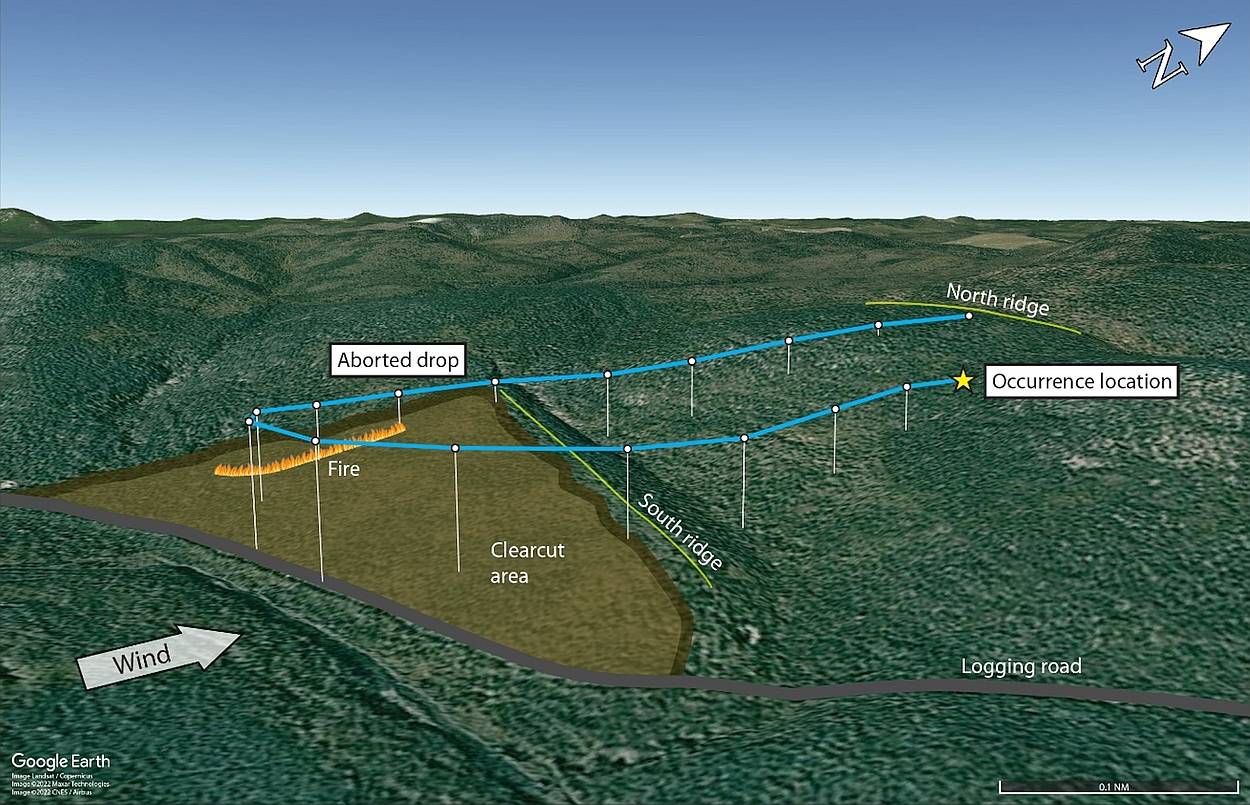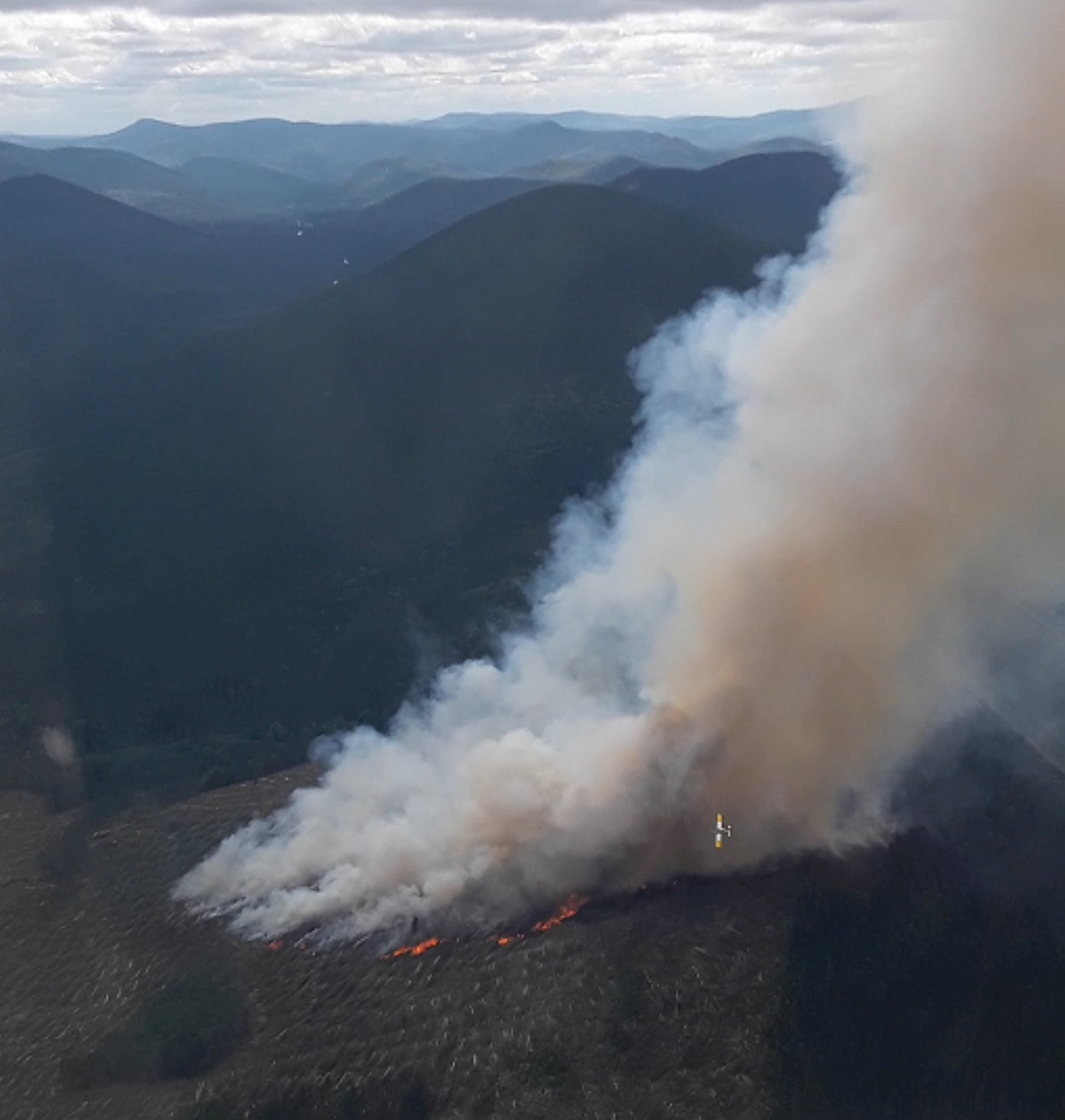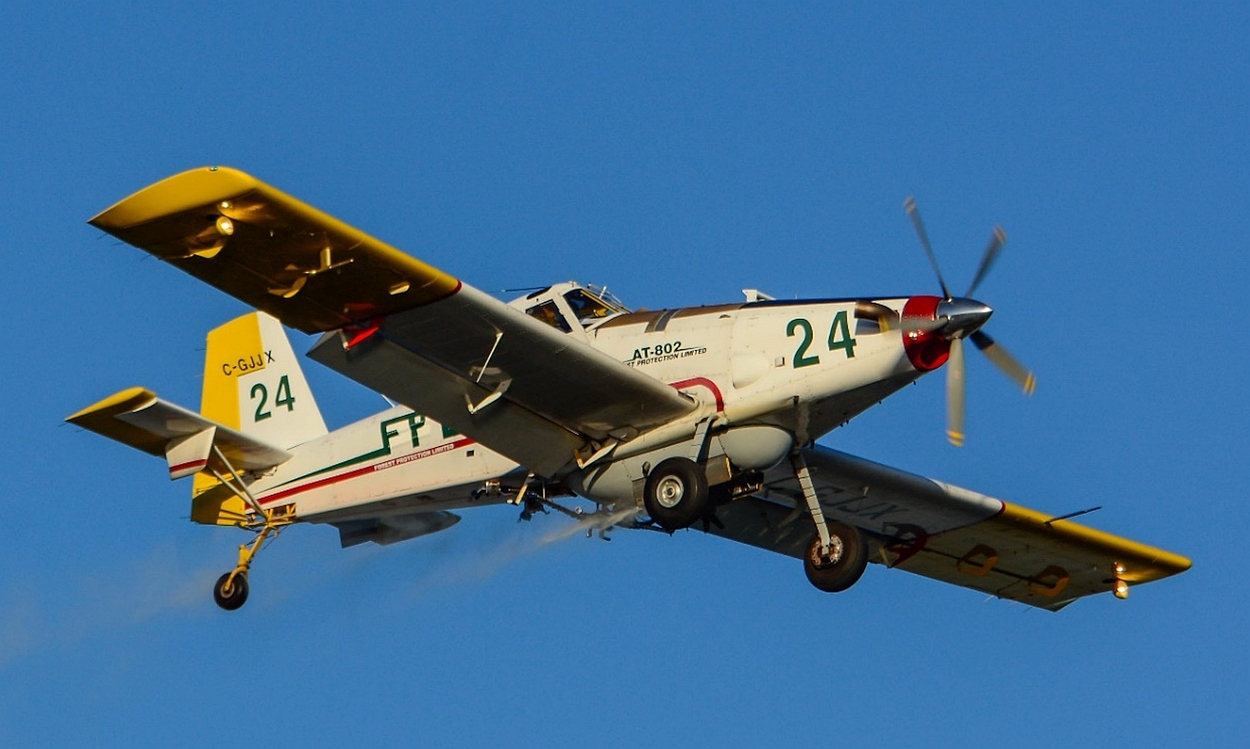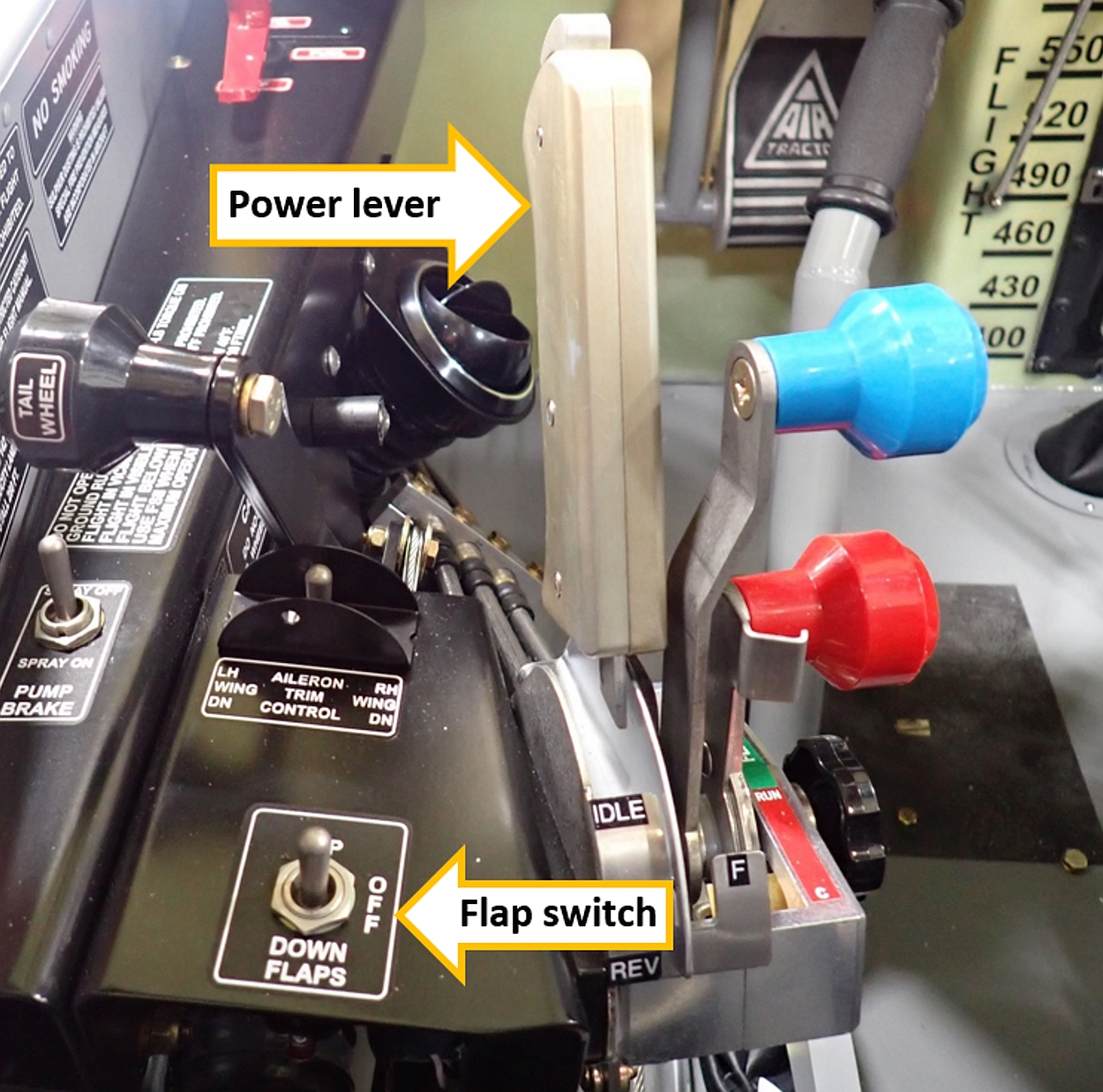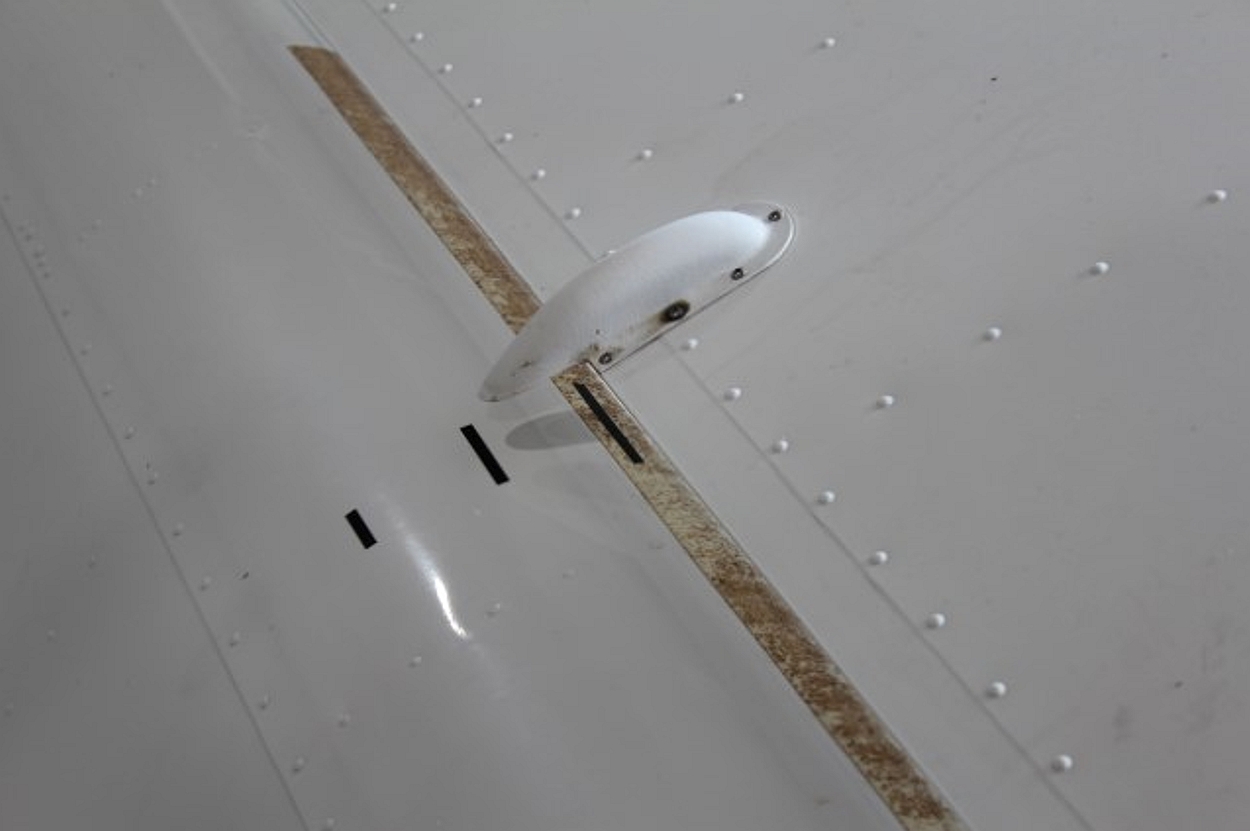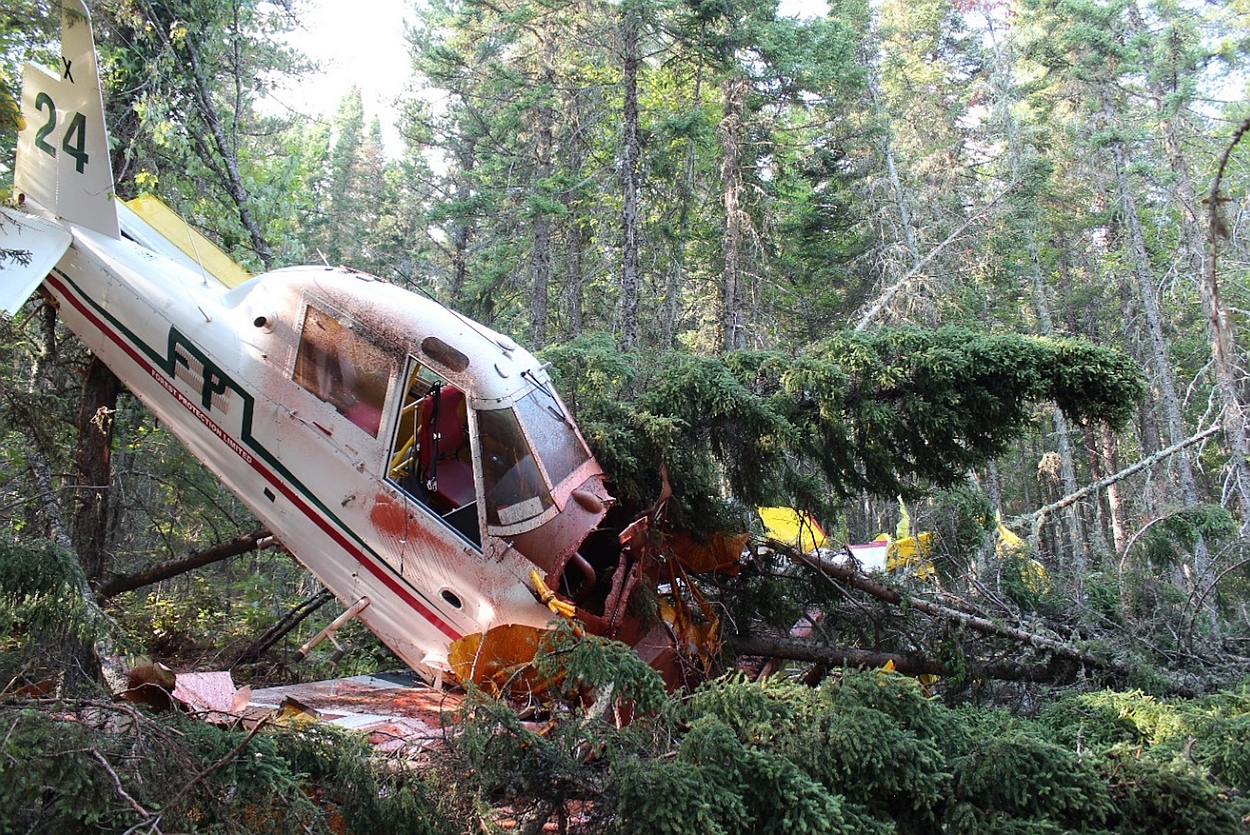Collision with terrain
Stall and collision with terrain
Forest Protection Limited
Air Tractor, Inc. AT-802, C-GJJX
Popple Depot, New Brunswick
The Transportation Safety Board of Canada (TSB) investigated this occurrence for the purpose of advancing transportation safety. It is not the function of the Board to assign fault or determine civil or criminal liability. This report is not created for use in the context of legal, disciplinary or other proceedings. See Ownership and use of content. Masculine pronouns and position titles may be used to signify all genders to comply with the Canadian Transportation Accident Investigation and Safety Board Act (S.C. 1989, c. 3).
Summary
On 11 August 2021, the Air Tractor, Inc. AT-802 aircraft (registration C-GJJX, serial number 802-0121) operated by Forest Protection Limited as Tanker 624 was conducting forest firefighting operations out of Miramichi Airport (CYCH), New Brunswick, with 1 crew member on board. At approximately 1553 Atlantic Daylight Time, the aircraft, while conducting the 4th bombing run of the day, impacted the hillside of a heavily wooded area of northern New Brunswick. The pilot sustained minor injuries. There was no post-impact fire; however, the aircraft was destroyed.
1.0 Factual information
1.1 History of the flight
At approximately 0900Footnote 1 on 11 August 2021, the pilot of the Air Tractor, Inc. (Air Tractor) AT-802 aircraft (registration C-GJJX, serial number 802-0121), operating as Tanker 624, arrived at Fredericton International Airport (CYFC), New Brunswick, for a daytime visual flight rules (VFR) flight to conduct a series of practice drops in one of Forest Protection Limited’s (FPL) training areas. Due to low clouds at CYFC, the practice drops were delayed until the weather improved.
Shortly before 1200, FPL’s Flight Operations department received a report from the Provincial Forest Firefighting Centre (PFFC) of a small, single-tree fire, and the PFFC changed the scheduled practice-drop training flight to an operational fire-reconnaissance flightFootnote 2 to investigate the reported fire.
For this fire reconnaissance flight, the occurrence aircraft, Tanker 624, was part of a team that consisted of a Piper PA60-600 Aerostar Bird Dog aircraft (BD172), an AT-802 Team LeadFootnote 3 (operating as Tanker 620), and another AT-802 aircraft.
The weather at CYFC had steadily improved, and, at approximately 1200, Tanker 624, along with the other 3 aircraft, departed. The reported fire was located in Popple Depot, a remote area of northern New Brunswick, located approximately 51 nautical miles (NM) northwest of the Miramichi Airport (CYCH), New Brunswick. Popple Depot is in an area of steep terrain, where the height between the valleys and peaks vary up to 2000 feet.
The first aircraft to arrive in the vicinity of the fire was the Bird Dog. The fire was located within an area of partially harvested trees, approximately 50 hectares in size (Figure 1).
It quickly became apparent to the Air Attack Officer (AAO) on board the Bird Dog aircraft that the fire was not a single-tree fire and that it was larger and spreading faster than had been originally thought. The AAO contacted the PFFC to request more resources, and an additional tanker and a shadow aircraftFootnote 4 were dispatched.
Bombing runsFootnote 5 are typically conducted with tanker aircraft approaching the fire downwind (tailwind), as this provides pilots with better visibility of the fire. In this occurrence, the fire was burning on the side of a steep hill and the tanker pilots needed to fly their aircraft downhill during the drop. This resulted in an approach to the fire that was into wind (headwind), making it more difficult than usual for the pilots to see their target. Throughout the day, several bombing runs conducted by various tanker pilots resulted in aborted drops.
At 1247, Tanker 624 was cleared for the drop by the AAO, and the load of foamFootnote 6 it was carrying on board was dropped on the fire. Tanker 624 was then instructed by the AAO to proceed to CYCH for reload. The tanker subsequently conducted 2 more drops over the fire, reloading each time at CYCH.
At 1531, Tanker 624 departed CYCH for the 4th drop of the day, after being loaded with 2081 L of fire retardant. Around the same time, another Bird Dog aircraft (BD175) was arriving in the vicinity of the Popple Depot fire to relieve the first Bird Dog (BD172), which required re-fuelling at CYCH. At approximately 1551, Tanker 624 also arrived in the area. As Tanker 624 entered the circuit around the fire from the north on a slant final,Footnote 7 Tanker 620, the Team Lead, was approximately 5 NM behind. The pilot of Tanker 624 completed the required checklists, began the final descent and configured the aircraft’s Fire Retardant Dispersal System in preparation for the drop.
At 1552:13, Tanker 624 crested the first ridge (north ridge) (Figure 2). At this point, Tanker 624 was at 2000 feet above sea level (ASL) and travelling at 92 knots indicated airspeed (KIAS).
At 1552:31, Tanker 624 crested the second (south) ridge. In an attempt to prevent the aircraft from accelerating while flying downhill and descending to the drop height,Footnote 8 the pilot set the flaps to a fully extended flap position (flaps 30°) and reduced the aircraft’s power lever to the idle position. Not being properly aligned to enable a safe drop, the pilot of Tanker 624 commenced an aborted drop. The pilot increased power to approximately 2200 foot-pounds of torque (53% of take-off powerFootnote 9), retracted the flaps to 20°, initiated a steep left-hand turn at a 45° angle of bank, and informed the AAO (Figure 3). Tanker 624 was at 1600 feet ASL and 100 KIAS when the go-around was initiated. At this altitude, the aircraft was between 60 and 100 feet above ground level (AGL).
Tanker 624, which had been heading south, turned approximately 90° to the left so that, by 1552:45, it was now heading in an easterly direction. The aircraft climbed approximately 100 feet, but because of falling terrain, the aircraft was approximately 500 feet AGL. Its airspeed decreased to 90 KIAS during the turn.
By 1552:56, Tanker 624 had turned another 90° from the east and was starting to crest the south ridge again, this time heading north, back up the hill for another drop attempt. The pilot was monitoring the aircraft’s position in relation to the fire, which was now behind his left shoulder. The aircraft now had a tailwind, and the power setting was slowly increased up to 2420 foot-pounds of torque (58% of take-off power). A few seconds later, the aircraft started to climb slowly, but because of rising terrain, the aircraft was now at a height of approximately 300 feet AGL and its airspeed was decreasing.
At 1553:10, at an altitude of 1800 feet ASL, the aircraft was now at approximately 100 feet AGL and at an airspeed of 78 KIAS. As the aircraft approached the terrain, the pilot commenced a turn to the left and heard an audio tone. Believing that this was the aircraft’s over-torque warning system activating,Footnote 10 the pilot reduced power to approximately 1890 foot-pounds of torque (approximately 45% of take-off power). Within 3 seconds, the aircraft stalled, entered an incipient spin, and struck the forest floor.
As the Bird Dog aircraft was positioning for Tanker 624’s subsequent drop attempt, the Bird Dog pilot observed Tanker 624 in a 90° bank attitude immediately before the aircraft disappeared into the forest. The Bird Dog pilot informed the AAO and proceeded to Tanker 624’s last known position. Once the position was located, the Bird Dog circled the wreckage, providing GPS (global positioning system) coordinates to the ground personnel who were working on the fire nearby. The AAO on board the Bird Dog aircraft informed those involved in firefighting activities of the situation and activated the emergency response.
The crash site was located on a steep hillside (on a slope of approximately 25°), which was heavily forested with coniferous trees. The crash site was difficult to see from the air, unless the Bird Dog crew was directly over the scene.
At 1557, the Joint Rescue Coordination Centre in Halifax, Nova Scotia, received a signal from the emergency locator transmitter (ELT) on board Tanker 624.
The occurrence pilot was able to exit the aircraft, and, at approximately 1630, he and the wreckage were located by ground searchers. The pilot was able to walk to a nearby road where transportation to the hospital was waiting.
1.2 Injuries to persons
The pilot, who was the sole occupant, received minor injuries. He was wearing a helmet and a 4-point safety belt.
| Degree of injury | Crew | Passengers | Persons not on board the aircraft | Total by injury |
|---|---|---|---|---|
| Fatal | 0 | - | - | 0 |
| Serious | 0 | - | - | 0 |
| Minor | 1 | - | - | 1 |
| Total injured | 1 | - | - | 1 |
1.3 Damage to aircraft
The aircraft was destroyed by impact forces. There was no post-impact fire.
1.4 Other damage
An unspecified amount of Jet A-1 fuel and Phos-Chek LC95Footnote 11 fire retardant was released onto the forest floor.
1.5 Personnel information
| Pilot licence | Airline transport pilot licence |
|---|---|
| Medical expiry date | 01 April 2022 |
| Total flying hours | 9264.5 |
| Flight hours on type | 57.3 |
| Flight hours in the 7 days before the occurrence | 4.3 |
| Flight hours in the 30 days before the occurrence | 7.1 |
| Flight hours in the 90 days before the occurrence | 33.5 |
| Flight hours on type in the 90 days before the occurrence | 31.4 |
| Hours on duty before the occurrence | 7.5 |
| Hours off duty before the work period | 17.5 |
The pilot held the appropriate licence and met the recency requirements for the flight in accordance with existing regulations.
The pilot began employment with FPL on a seasonal contract as a tanker pilot on the AT-802 in April 2020. All of the pilot’s experience on type was obtained conducting flights related to forest firefighting activities. The pilot’s last pilot competency check on the AT-802 was completed on 31 March 2021.
Based on a review of the pilot’s work and rest schedule, fatigue was not considered a factor in this occurrence.
1.6 Aircraft information
| Manufacturer | Air Tractor |
|---|---|
| Type, model and registration | AT-802, C-GJJX |
| Year of manufacture | 2002 |
| Serial number | 802-0121 |
| Certificate of airworthiness/flight permit issue date | 16 April 2002 |
| Total airframe time | 1360.4 hours |
| Engine type (number of engines) | Pratt & Whitney PT6A-67-AG (1) |
| Propeller (number of propellers) | Hartzell HC-B5 MA-3D (1) |
| Maximum allowable take-off weight | 16 000 lb (7257 kg) |
| Recommended fuel type(s) | Jet A, Jet A-1, Jet B |
| Fuel type used | Jet A-1 |
The Air Tractor AT-802 is a single-seat, low-wing design, manufactured with a standard tail-wheel style of undercarriage and intended specifically for agricultural spray applications (Figure 4). It can also be configured for use in fire bombing. Its design was certificated under the U.S. Federal Aviation Regulations in the restricted category. The aircraft operates in Canada under a Special Certificate of Airworthiness—Restricted classification.Footnote 12
A Trotter Controls GEN II Fire Retardant Dispersal System had been installed in this aircraft for the purpose of fire bombing.
Records indicate that there were no outstanding defects at the time of the occurrence. There was no indication that a component or system malfunction played a role in this occurrence.
The weight and centre of gravity were within the prescribed limits.
1.6.1 Stall speeds
The Air Tractor AT-802 airplane flight manual (AFM)Footnote 13 contains a performance section that includes a table (Table 4) indicating the calculated stall speeds at 2 different weights: 12 500 pounds and 16 000 pounds.
| Aircraft weight | Flap configurations | 0° bank angle (level flight) (KCAS*) | 15° bank angle (KCAS) | 30° bank angle (KCAS) | 45° bank angle (KCAS) | 60° bank angle (KCAS) |
|---|---|---|---|---|---|---|
12 500 lb (5670 kg) |
Flaps up (0°) | 81 | 83 | 87 | 96 | 115 |
| Flaps down (30°) | 71 | 72 | 76 | 85 | 101 | |
16 000 lb (7257 kg) |
Flaps up (0°) | 92 | 94 | 99 | 109 | 130 |
| Flaps down (30°) | 81 | 83 | 87 | 96 | 115 |
* KCAS: knots calibrated airspeed
The investigation determined that the weight of the aircraft at the time of the occurrence was approximately 14 500 pounds (6577 kg); however, the bank angle could not be determined. The last recorded indicated airspeed was 72 KIAS.
1.6.2 Stall and over-torque warnings
The stall warning and the over-torque warningFootnote 14 systems both employ auditory alarms that each inform the pilot about a different state of aircraft operation. The stall warning horn will begin to sound continuously from a cockpit speaker both when the aircraft wing is approaching an aerodynamic stall condition and during a stalled condition.
The over-torque warning system has both audio and visual qualities. When engine output torque is beyond the limit of 4170 foot-pounds of torque, a tone sounds within the pilot’s headset and an amber light illuminates on the instrument panel. Both the over-torque tone and the amber light will remain on until the engine output torque is reduced below the aforementioned threshold.
Stall and over-torque warning system recordings were taken from an exemplar aircraft. An analysis of each tone was performed to determine the acoustic structure of the tones.
The stall warning horn is a tone with a fundamental frequency occurring at approximately 2700 Hz. The over-torque warning horn is a tone with a fundamental frequency occurring at approximately 1287 Hz. The 2 tones sound similar given that they are both continuous and do not vary in rhythm or tempo.
1.6.3 Flaps
Flaps are mechanical, high-lift devices installed on the trailing edge of most modern aircraft that are designed to increase the amount of lift and reduce the aircraft’s stall speed by changing the shape or camber of the wing. In addition to increasing lift, flaps also increase drag.
The flaps on the AT-802 are electrically operated and can be stopped in any position between fully retracted (up, or 0° flaps) and fully extended (down, or 30° flaps). The flaps are controlled by a switch that is spring-loaded to its centre OFF position. The flap switch is adjacent to the power lever on the left side of the cockpit (Figure 5). The pilot must remove his or her hand from the power lever to operate the flap switch.
The pilot adjusts the flap position by holding the spring-loaded switch forward to the UP position while retracting the flaps, or by holding the switch back to the DOWN position while extending them. They are adjusted by aligning one of the flap indicators (black lines), located on the left flap, with the trailing edge of the wing (Figure 6). To set the flaps to a specific setting, the pilot needs to look out the window at the flap indicator; there is no haptic, visual, or audio feedback in the cockpit informing the pilot of the flap level selected. It normally takes 2 seconds to move the flaps through each 10° of movement (6 seconds to move flaps from fully extended to fully retracted, or vice versa).
1.7 Meteorological information
The automated weather observation system (AWOS) at Bathurst Airport (CZBF), New Brunswick, the nearest reporting station (about 35 NM east-northeast of the occurrence site), issued the following aerodrome routine meteorological report (METAR) at 1500:
- winds from 170° true (T) at 9 knots, gusting to 17 knots; winds variable from 140°T to 230°T
- visibility 9 statute miles
- few clouds at 3300 feet AGL
- temperature 28 °C
- altimeter setting 29.99 inches of mercury
The METAR for CZBF issued at 1600 indicated the following:
- winds from 170°T, at 9 knots, gusting to 16 knots
- visibility 9 statute miles
- few clouds at 3700 feet AGL
- temperature 28 °C
- altimeter setting 29.98 inches of mercury
1.8 Aids to navigation
Not applicable.
1.9 Communications
Not applicable.
1.10 Aerodrome information
Not applicable.
1.11 Flight recorders
The aircraft was not equipped with a cockpit voice recorder or a flight data recorder, nor was either required by regulation.
The aircraft was equipped with a satellite flight tracking unit and an aircraft data acquisition system (ADAS). The electronic flight and engine data pertaining to the occurrence flight, obtained from these systems, was used for the investigation.
1.12 Wreckage and impact information
The aircraft struck a number of trees before it made contact with the forest floor. As a result of the impact with the ground, the fuselage was displaced from the wing centre section. The propeller and reduction gearbox had detached from the engine, which itself had detached completely from its mounting structure. The front section of the aircraft from the aft hopper wall forward was destroyed. The leading edge of each wing was found displaced rearward due to impact with the ground, and both wingtips had been destroyed by impact with the trees. Both horizontal stabilizers were partially detached from the fuselage. Each main landing gear had detached from the aircraft structure. The cabin area remained almost completely intact with the majority of the damage located in the areas of the windscreen, engine control quadrant, and instrument panel. On-site wreckage examination did not reveal any pre-impact failures (Figure 7).
1.13 Medical and pathological information
According to information gathered during the investigation, there was no indication that the pilot’s performance was affected by medical factors.
1.14 Fire
There was no aircraft fire either before or after the occurrence.
1.15 Survival aspects
The pilot was wearing a helmet and using the available 4-point safety belt at the time of the occurrence. Due to deceleration forces, the pilot received minor injuries to the neck and chest area from the aircraft’s shoulder harnesses.
The 406 MHz ELT on board the occurrence aircraft operated as designed. The Joint Rescue Coordination Centre in Halifax received a signal from the aircraft’s ELT through the Cospas-Sarsat system within 4 minutes of the time of impact.
1.16 Tests and research
1.16.1 TSB laboratory reports
The TSB completed the following laboratory reports in support of this investigation:
- LP107/2021 – Non-Volatile Memory Data Recovery – Aircraft Data Acquisition System/GPS (Global Positioning System) Tracker
- LP118/2021 – Instruments Analysis
- LP166/2021 – Fire Retardant Dispersal System Release Switch Analysis
- LP167/2021 – Audio Analysis
1.17 Organizational and management information
FPL holds an air operator certificate and operates in accordance with Subpart 702 (Aerial Work) of the Canadian Aviation Regulations (CARs). The company also holds an approved maintenance organization certificate. Its maintenance activities are conducted in accordance with Subpart 573 of the CARs.
At the time of the occurrence, FPL’s fleet consisted of 15 aircraft: 8 Air Tractor AT-802s and 7 Piper PA60-600 Aerostar aircraft.
FPL offers the following services:
- aerial forest firefighting,
- pest and vegetation management, and
- aerial surveys.
FPL did not have a safety management system at the time of the occurrence, nor was one required by regulation.
1.18 Additional information
1.18.1 Airspeed and flap settings for bombing runs
The airspeed and use of flaps during aerial firefighting bombing runs are discussed in several documents made available to FPL pilots. These documents include: the FPL AT-802 standard operating procedures (SOPs),Footnote 15 the AFM for the Air Tractor model AT-802, and FPL’s Fire Suppression Manual.Footnote 16
FPL discusses the use of flaps during firefighting activities in multiple sections of its SOPs. Subsection 4.10 Bombing Run states:
Normally the aircraft will be stabilized at 105 KIAS with flaps 20° over the target. 105 KIAS is considered the normal bomb speed.Footnote 17
Subsection 4.12 discusses an acceptable flap setting range and states the following:
When a steep downhill run is required, the following procedure can be used to control airspeed.
When fully loaded:
- Establish on base at 95-100 KIAS with flaps 10-20° and Prop 1700 RPM.Footnote 18
The Air Tractor AT-802 AFM recommends using 10° of flap. Section 2: Normal Procedures states:
During fire control operations when approaching the drop target, aircraft airspeed should be reduced to between 125 mph (109 kts [knots]) and 130 mph (113 kts [knots]). The onboard computer, when properly set, will control the drop according to the set ground speed.
It is recommended that 10° of flap be used during the approach and load release phase, which creates a very stable approach condition. Note that 10° is the first mark seen on the flap leading edge as the flaps are being lowered.Footnote 19
The FPL Fire Suppression Manual is another document that provides guidance to company operations personnel in the execution of their duties in fire suppression operations. The manual advises pilots to reference the AFM for specific operating instructions, but also suggests using flaps 1/3 (10° of flap).
See aircraft POH or Flight Manual for specific checklists and operating instructions.
Check Fuel On and sufficient; Recirc ON as required; inject Foam as required; Landing Lights extended and ON; check temperatures and pressures; Propellor [sic] 1700 RPM
Airspeed 100 KIAS; flaps 1/3Footnote 20
1.18.2 Balked landings and aborted drops
A balked landing is a discontinued landing attempt and is typically initiated at low altitude but before touchdown.Footnote 21A balked landing normally leads to or results in a go-around.
Air Tractor defines the procedure for conducting a balked landing/go-around in the AT-802 AFM:
BALKED LANDING/GO-AROUND:
- Power Lever – ADVANCE for takeoff power
- Attitude – Pitch to approximate 7 degrees nose up
- Wing Flaps – RETRACT to 20°.
- Climb Speed – 100 mph (87 knots) until obstacle are cleared.
- Wing Flaps – RETRACT after reaching safe altitude and 115 mph (100 KIAS) climb speed.Footnote 22
Aborted drops are conducted when a tanker aircraft is not aligned with the proposed target, when a malfunction with the load release system occurs, or when a drop cannot be safely accomplished.
An aborted drop differs from the balked landing/go-around procedure since there is no intention to conduct a landing, and it requires the tanker aircraft to fly away from the target area with the contents of the hopper still on board the aircraft.
In their manuals, neither Air Tractor nor FPL specifies the procedure to follow in the event of an aborted drop.
1.18.3 Training in areas of steep or mountainous terrain
In order to provide flight crews with the opportunity to maintain proficiency during extended periods of low fire index, FPL pilots conduct practice drops.
FPL has designated 2 areas to conduct these practice drops. These practice areas are located a relatively short distance from the main base of operation (within 27 NM of CYFC) and are representative samples of the relatively level terrain found in the majority of New Brunswick.
These practice areas are, however, quite different from the steep terrain encountered in the vicinity of the Popple Depot fire.
FPL pilots did not receive training for flying in areas of steep or mountainous terrain. The Fire Suppression Manual did include a supplement titled “Mountain Flying” (section 4.1); however, at the time of the occurrence, the supplement was blank.
In this occurrence, the steep terrain made aligning the aircraft with the target challenging because the fire was obscured by a ridgeline, which contributed to the overall difficulty of this drop.
1.18.4 Illusions in steep or mountainous terrain
The most accurate sensory information available to a pilot about aircraft attitude and motion are the visual cues provided by the earth's horizon, the aircraft's flight instruments, or both. The Civil Aviation Authority of New Zealand published a booklet titled Mountain FlyingFootnote 23 that describes common illusions a pilot may experience.
The booklet describes the false horizons illusion that occurs because of the frequent absence of a defined external horizon, which can lead to aircraft attitude and airspeed problems. It states that,
[w]hen flying among the mountains, or anywhere the horizon is not visible, the pilot must learn to imagine that horizon. […] In a confined space with reduced visibility, [the pilot’s] eyes must be outside, and performance must be interpreted by any subtle change in nose attitude and only confirmed by instruments.Footnote 24
Inexperienced pilots often fall into the common trap of using a ridgeline as the horizon and unintentionally altering the aircraft attitude, climbing the aircraft with a corresponding decrease in airspeed, and not making a timely decision to reverse course. The horizon goes through the base of the mountains, not the ridges. This illusion may also be exacerbated by the blending of ridgelines in the distance, due to a lack of contrast.
Optic flowFootnote 25 is used to estimate height above ground and speed, especially when positional cues are reduced or absent. Closer objects move more rapidly in the optic flow field compared to the relatively slow angular velocities of more distant objects and terrain.Footnote 26,Footnote 27 Increased optic flow can provide an indication of increasing speed or decreasing altitude.
An upslope illusion occurs when flying towards rising terrain. As the slope ascends, the dense vegetation on the hills can disguise the sloping terrain, resulting in the pilot estimating the aircraft’s height as being higher than it really is.Footnote 28
The relative velocity of the images moving across the retina is also used to determine one’s speed. When a pilot is flying over rising terrain, the objects directly in front of the cockpit are closer than they are when the pilot is flying over flat terrain. Because objects that are close are perceived as moving faster than more distant objects,Footnote 29 a pilot flying above rising terrain may perceive the speed of the aircraft as being higher than it actually is. This illusion of higher speed in relation to the ground gets compounded when the aircraft is in a tailwind condition.
1.18.5 Perception and discrimination of auditory alarms
Alarms are “effective tools for conveying critical information in cognitively demanding
environments.”Footnote 30 Auditory alarms can be particularly useful because they can be perceived from everywhere in the cockpit and they offer a quick response time.Footnote 31
As described in Human Factors, for an auditory alarm to be effective, it needs to be “audible, identifiable, and interpretable.”Footnote 32 Audibility refers to whether a sound can be perceived within the ambient noise. The identifiability and interpretability imply that the sound will be “interpreted as an alarm and that its meaning will be understood.”Footnote 33
Most auditory alarms are abstract sounds that the operator needs to recognize and associate with a meaning. However, abstract alarms are difficult to learn,Footnote 34 especially if their temporal structure and pitch range are similar. Indeed, people’s ability to remember a certain pitch decays with time, making sounds with similar acoustic structure easily confused with one another.Footnote 35,Footnote 36
This can be explained by how sounds are treated and discriminated. According to the Cohort Theory of sound (or linguistic) recognition,Footnote 37 the initial sound perceived by the operator activates a cohort of possible matches in memory. As the sound progresses, the number of possible matches is narrowed. The identification occurs once only one possible match remains.Footnote 38 However, in the presence of a continuous tone, this identification process cannot be completed, and the operator needs to rely on associative memoryFootnote 39 to identify the meaning of the alarm.Footnote 40 This process is less successful and requires frequent exposure for an alarm to be easily associated with its meaning.Footnote 41 Therefore, for alarms to be effectively identified, they need to be as distinctive as possible, varying in rhythm, timbre, and tempo.Footnote 42
1.18.6 Workload
The relation between workload and human performance is not linear; too small a workload can be as detrimental as an excessive workload. An excessive workload occurs when performing a task requires more resources than are available, resulting in reduced performance. An increase in the workload can be caused by various factors, including an operator’s level of experience. Indeed, novices experience higher workload than experts when performing the same task.Footnote 43 Expert pilots encountering an unfamiliar situation will also experience an increase in workload.
A marked increase in workload can limit attention span, increase stress, and reduce working memory.
1.18.7 Divided attention
Attention is a limited cognitive resource. When a task requires a person to pay attention to several aspects of the environment, or if more than one task needs to be completed simultaneously, attention is divided. However, divided attention comes at a cost: typically, the performance of one task or both tasks will be negatively affected.
1.18.8 Development of adaptations
An adaptation is a practice that consists of intentionally deviating from rules, instructions, or procedures. While policies and procedures are prescribed in order to set boundaries for safe operations, individuals may experiment with the boundaries in order to become more productive or obtain some other benefit. This leads to adaptations of procedures and a shift beyond the prescribed boundaries described in company operating procedures toward unsafe practices.Footnote 44
2.0 Analysis
An examination of the wreckage showed no indication that an aircraft system malfunction contributed to this occurrence. The analysis will focus on the factors that contributed to the aircraft departing controlled flight.
2.1 Arrival at the fire and the aborted drop
Aerial firefighting is a high-risk, workload-intensive activity. Pilots need to divide their attention between flying the aircraft, monitoring their environment, and communicating with others to synchronize their work. In this occurrence, the pilot’s workload was increased even more by the environmental conditions (e.g. smoke, wind direction) and, in particular, the steep terrain. In the presence of a novel situation, pilots cannot rely on past experiences to guide their decisions. Therefore, each decision requires more cognitive resources than usual. Both workload that is too high and divided attention are known to hinder performance.
As the occurrence aircraft (Tanker 624) arrived at the fire for the 4th drop of the day, the pilot entered the circuit on a slant final. As a result, there was now less time for the pilot of Tanker 624 to complete the required checklist items, program the Fire Retardant Dispersal System, and align the aircraft for the drop.
The location of the Popple Depot fire proved to be challenging for all of the Forest Protection Limited (FPL) tanker pilots on that day. The fire was burning on the side of a steep hill and the multiple ridges on the approach made it difficult to descend to the drop altitude while maintaining a safe drop speed. In response, the occurrence pilot reduced the power lever to idle. In addition, the flaps were extended beyond the standard 10° or 20° setting, as specified in guidance material, in an effort to increase drag and prevent the aircraft from accelerating beyond the recommended drop speed as it flew down the side of a hill.
Just before reaching the target, the pilot realized that the aircraft was not aligned, and he initiated an aborted drop. The aborted drop procedure differed from that of a balked landing/go-around, and none of the aircraft or company procedures manuals specified the procedures to follow in the event that an aborted drop is required.
Workload increased as the pilot initiated a steep, 45° angle of bank turn away from the fire, advanced the power, and retracted the flaps. At the same time, the pilot was communicating with the Air Attack Officer (AAO) and trying to position the aircraft for the next bombing run.
During the aborted drop, the power lever was initially advanced to 2200 foot-pounds of torque (53% of available power). Over the next 15 seconds, the power slowly climbed to its maximum value after the aborted drop of 2420 foot-pounds of torque (58% of available power); however, the pilot did not note the exact power setting. There were no further increases made to the power setting. The pilot’s hand had to be removed from the power lever to retract the flaps because the spring-loaded flap switch required the pilot to hold the switch in position the entire time that the flaps were being retracted.
The pilot held the flap switch in the UP position for approximately 2 seconds. Because the flaps were set to the non-standard flap 30° setting during the bombing run, the flaps were retracted only to 20°. As a result, more drag than normal remained on the aircraft after the aborted drop.
Finding as to causes and contributing factors
During the aborted drop, the power was increased to 58% of the available power, and the flaps were retracted from 30° to 20°. Due to the pilot’s high workload and divided attention, these settings went unnoticed.
As the pilot continued the left-hand turn and proceeded to fly back up the hill to conduct another drop, his attention continued to be divided. The fire was now positioned behind and to the left of the aircraft, requiring the pilot to focus on many different areas at the same time, including the terrain in front of the aircraft, the fire behind the aircraft and to the left, as well as the aircraft’s instrumentation inside the cockpit.
Initially, the selected power and flap settings did not pose an immediate threat, since the aircraft was maintaining level flight, but as the aircraft approached the rising terrain and a climb was initiated, the aircraft’s speed deteriorated.
Finding as to causes and contributing factors
The selected power setting, combined with the flap setting, contributed to a reduced airspeed as the aircraft entered a slow climb to avoid rising terrain.
2.2 Illusions created by steep terrain
It is important for pilots to be aware of their surroundings when flying in areas of steep terrain to ensure that a minimum safe altitude is maintained. This is particularly challenging when conducting forest fire operations, which often require aircraft to be operated in close proximity to the ground.
Steep terrain or mountains can sometimes generate the illusion of a false horizon, creating a situation in which a climb is unintentionally initiated, leading to a reduction in airspeed. This illusion can be particularly dangerous when an aircraft is operating at airspeeds close to its stall speed.
In this occurrence, after the aborted drop, the aircraft was flying towards rising terrain, which created several illusions for the pilot. These illusions, combined with the tailwind at low altitude, gave the pilot the appearance that the aircraft was travelling faster than it actually was. This likely solidified the pilot’s belief that the aircraft’s airspeed was sufficient.
Finding as to causes and contributing factors
As the aircraft approached rising terrain, the low altitude and tailwind resulted in the pilot perceiving that the airspeed was sufficient when, in fact, it was decreasing.
2.3 Warning system audio tone similarities
The acoustic structures of the stall and over-torque alarms are similar in that they are both continuous tones and do not present variation in rhythm or tempo. They do, however, alert the pilot to 2 very different flight conditions.
The fundamental frequency of the stall warning horn is approximately 2700 Hz, while the fundamental frequency of the over-torque horn is approximately 1287 Hz. This difference in frequency is sufficient to be perceived when the alarms are played one after the other, but they may not be easily discriminated and identified when they sound individually. Indeed, abstract alarms are very hard to learn. To facilitate recognition, alarms need to be heterogenous, that is, they must vary in tone, frequency, and temporal structure. Melodic alarms, for example, are easier to discriminate than single tones.
Findings as to causes and contributing factors
As the aircraft approached the stall, the stall warning horn sounded. Because the pilot perceived the aircraft’s speed to be sufficient, the pilot identified this audio tone to be the sound that warns of an over-torque condition, and as a result, he decreased power.
As a result of the decreased power, the aircraft decelerated further, stalled, and entered an incipient spin at an altitude too low to permit recovery.
Training
2.4.1 Target speeds and the use of flaps
The guidance material available to FPL pilots regarding target speeds to be flown and the use of flaps during firefighting activities can be found in a number of different documents.
Depending on which manual is used, the target speed can vary from 95 knots to 113 knots, and flaps, from 10° to 20°.
Having all of these options available can lead to pilots not knowing which procedure to follow. Without clarity on these procedures, there is potential for pilots to create their own interpretations or develop new procedures.
Finding as to risk
If company operating procedures contain conflicting information in different publications, there is an increased risk of employees making procedural errors or adaptations that can lead to unsafe practices.
2.4.2 Areas of steep or mountainous terrain
FPL pilots are provided the opportunity to conduct practice drops. The areas designated for these drops have relatively flat terrain.
Certain regions in New Brunswick contain areas of steep or mountainous terrain, and the topography in these areas is quite different from the areas where FPL pilots conduct their practice drops.
FPL’s Fire Suppression Manual does include a supplement titled “Mountain Flying”; however, at the time of the occurrence, this section of the manual remained blank. No additional guidance was provided to FPL pilots regarding the hazards, such as illusions, involved when flying in areas of steep or mountainous terrain.
Findings as to risk
If pilots are not trained on the hazards associated with low-level flying in areas of steep or mountainous terrain, there is an increased risk of collision with terrain.
3.0 Findings
3.1 Findings as to causes and contributing factors
These are conditions, acts or safety deficiencies that were found to have caused or contributed to this occurrence.
- During the aborted drop, the power was increased to 58% of the available power, and the flaps were retracted from 30° to 20°. Due to the pilot’s high workload and divided attention, these settings went unnoticed.
- The selected power setting, combined with the flap setting, contributed to a reduced airspeed as the aircraft entered a slow climb to avoid rising terrain.
- As the aircraft approached rising terrain, the low altitude and tailwind resulted in the pilot perceiving that the airspeed was sufficient when, in fact, it was decreasing.
- As the aircraft approached the stall, the stall warning horn sounded. Because the pilot perceived the aircraft’s speed to be sufficient, the pilot identified this audio tone to be the sound that warns of an over-torque condition, and as a result, he decreased power.
- As a result of the decreased power, the aircraft decelerated further, stalled, and entered an incipient spin at an altitude too low to permit recovery.
3.2 Findings as to risk
These are conditions, unsafe acts or safety deficiencies that were found not to be a factor in this occurrence but could have adverse consequences in future occurrences.
- If company operating procedures contain conflicting information in different publications, there is an increased risk of employees making procedural errors or adaptations that can lead to unsafe practices.
- If pilots are not trained on the hazards associated with low-level flying in areas of steep or mountainous terrain, there is an increased risk of collision with terrain.
4.0 Safety action
4.1 Safety action taken
4.1.1 Forest Protection Limited
After the occurrence, Forest Protection Limited (FPL) revised its Fire Suppression Manual in a focus group with its most experienced fire suppression pilots and in consultation with the Provincial Forest Firefighting Centre. The manual was amended to include the following new practices:
- High-level and low-level inspection runs are to be conducted by the Bird Dog team to verify hazards.
- Tanker pilots must ensure that they are in level flight before they reach the target.
- Tanker pilot procedures for an aborted drop were developed, including the requirement for 2 positive rates of climb before returning for a 2nd attempt.
FPL also amended its training to include:
- Annual mountain flying training.
- An approach to stall recovery with a loaded aircraft during the airborne portion of training. This training exercise was previously completed by all FPL tanker pilots; however, it was not clearly stated in the training document.
- More frequent fire practice missions with deliberate objectives, including operations in various stack configurations, locations and terrain.
This report concludes the Transportation Safety Board of Canada’s investigation into this occurrence. The Board authorized the release of this report on . It was officially released on .

